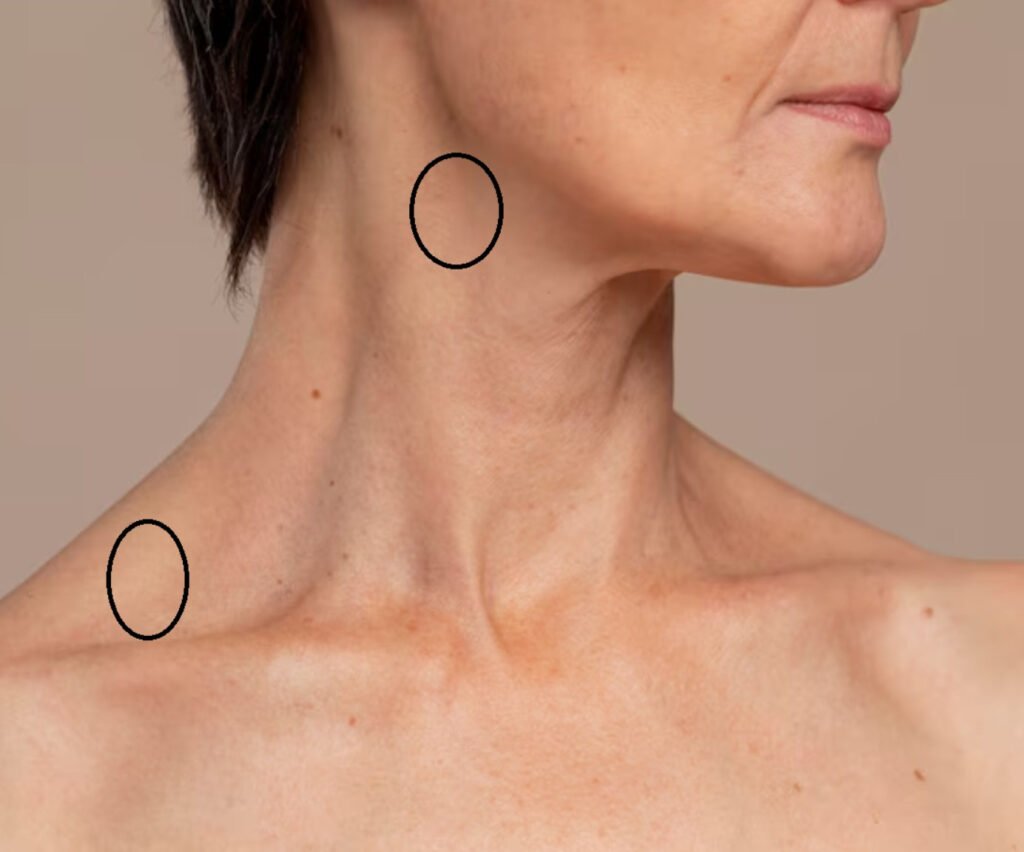Following photo is showing exact location of electrode placement

Advanced TENS machine is necessary for this application
Position of neck electrode: Just below the angle of mandible on left side. Another electrode on the same side shoulder.
Mode: DIY, Frequency: 30-50 Hz. Intensity: 3-5, Duration: 30-90 minutes and once a day for 3 months and twice a week for 1 year.
Following photo is showing exact location of electrode placement.
Non-invasive Vagus Nerve Stimulation (nVNS) is a rapidly evolving therapeutic approach that involves stimulating the vagus nerve externally, typically at the neck or ear, without the need for surgical implantation. The vagus nerve is a crucial component of the autonomic nervous system, playing a significant role in regulating various bodily functions, including heart rate, digestion, and inflammation. Its widespread connections to the brain and organs make it a promising target for modulating numerous physiological processes.
Here are the key indications for non-invasive vagal stimulation treatment, including both FDA-approved uses and areas of active research:
FDA-Approved Indications in the US
As of the current knowledge, the primary FDA-approved indications for non-invasive vagus nerve stimulation are:
- Cluster Headache (Acute Treatment): Specific nVNS devices (e.g., gammaCore) are approved for the acute treatment of pain associated with episodic cluster headache in adults. This means it can be used to alleviate the pain during a cluster headache attack.
- Migraine (Acute Treatment and Prevention): Certain nVNS devices (e.g., gammaCore) are also approved for the acute treatment of pain associated with migraine, and for the preventive treatment of migraine.
- Stroke Rehabilitation: The MicroTransponder Vivistim Paired VNS System is approved as an adjunctive to rehabilitation therapy for people who have moderate to severe upper extremity motor deficits associated with chronic ischemic stroke. It works by “pairing” the nerve stimulation with specific rehabilitation exercises to promote neuroplasticity.
Note: It’s important to distinguish nVNS from implantable Vagus Nerve Stimulation (iVNS), which has broader and longer-standing FDA approvals for:
- Treatment-resistant Epilepsy: As an add-on therapy for focal (partial) seizures in adults and children (4 years and older) when medications haven’t controlled their seizures.
- Treatment-resistant Depression: For adults (18 years and older) with long-term or recurrent major depression that hasn’t responded to four or more antidepressant treatments.
Investigational and Emerging Indications (Areas of Active Research)
Beyond the FDA-approved uses, non-invasive vagal stimulation is being actively investigated for a wide range of conditions due to the vagus nerve’s extensive involvement in bodily functions and its anti-inflammatory and neuromodulatory properties. These include:
- Other Chronic Pain Conditions:
- Fibromyalgia: To help manage widespread chronic pain, fatigue, and other symptoms by modulating central pain processing and inflammation.
- Chronic Low Back Pain: As a potential non-pharmacological option.
- Rheumatoid Arthritis and other Autoimmune/Inflammatory Disorders: The vagus nerve plays a crucial role in the “cholinergic anti-inflammatory pathway,” which can inhibit the release of pro-inflammatory cytokines. This makes nVNS a promising area of research for conditions like rheumatoid arthritis, inflammatory bowel disease (IBS/IBD), and sepsis.
- Post-Operative Pain: To potentially reduce pain and opioid use after surgery.
- Psychiatric and Neurological Conditions:
- Anxiety Disorders: Including generalized anxiety disorder, panic disorder, and PTSD, due to its role in regulating the autonomic nervous system and stress response.
- Bipolar Disorder: As a potential adjunctive therapy.
- Addiction and Substance Use Disorders: Particularly for managing withdrawal symptoms and cravings.
- Tinnitus: To alleviate ringing in the ears.
- Alzheimer’s Disease and Cognitive Disorders: Research is exploring its potential to improve cognitive function.
- Disorders of Consciousness: Such as unresponsive wakefulness syndrome (formerly vegetative state) and minimally conscious state, to promote brain activation and recovery.
- Cardiovascular Conditions:
- Heart Failure: To improve cardiac function and quality of life in some patients.
- Atrial Fibrillation: Studies are exploring its capacity to reduce the inducibility of atrial fibrillation.
- Exercise Capacity: Research indicates it may improve cardiorespiratory fitness and attenuate inflammation in healthy individuals.
- Gastrointestinal Disorders:
- Irritable Bowel Syndrome (IBS) and Inflammatory Bowel Disease (IBD): Due to the vagus nerve’s extensive innervation of the GI tract and its anti-inflammatory effects.
- Functional Abdominal Pain Disorders: In both adults and children.
- Rehabilitation:
- Post-Stroke Rehabilitation (Beyond Arm/Hand Function): Exploring its role in improving other motor deficits, swallowing difficulties (dysphagia), and cognitive impairments after stroke.
Key Considerations for nVNS Indications:
- Non-Invasive Nature: A significant advantage is that nVNS avoids the surgical risks and costs associated with implantable VNS devices.
- Safety Profile: Generally well-tolerated with common side effects being mild and transient (e.g., skin irritation, tingling sensation, neck pain, voice changes).
- Adjunctive Therapy: Like TENS, nVNS is often used as a complementary therapy, not a standalone cure. It works best when integrated into a comprehensive treatment plan.
- Evolving Research: While promising, many of the investigational indications require more robust clinical trials to establish definitive efficacy and optimal treatment protocols.
- Device Specificity: Different nVNS devices may be designed to target specific branches of the vagus nerve or use different stimulation parameters, which can influence their efficacy for various conditions.
- Patient Selection: As with any medical treatment, careful patient selection is crucial. A healthcare professional should always be consulted to determine if nVNS is appropriate for an individual’s specific condition and circumstances.
The growing understanding of the vagus nerve’s role in regulating various bodily systems, coupled with advancements in non-invasive technology, continues to expand the potential applications of nVNS as a therapeutic tool.
